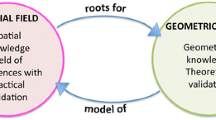Abstract
The purpose of the present study is to document, compare, and analyze the nature of spatial reasoning by practitioners (plumbers) in the workplace and students in the school setting while constructing solids, with given specifications, from plane surfaces. Data were collected from a plumbing workshop and five high school students while constructing a cylindrical container of capacity one-liter and height of 20 cm. The results confirm the power of activity theory and its methodology in explaining and identifying the structural differences between the two activities in the two different cultural settings. Students and plumber activity structures differed in the operational aspect (actions) and the means and concrete conditions (operations) under which such a goal is carried out. Activity theory has the potential to explain the differences between the two activities in terms of differences in the motive, social-cultural settings, the tools that were available and accessible which resulted in different actions, and the constraints (operations) under which the task was executed. Theoretical and pedagogical implications were identified.
Similar content being viewed by others
REFERENCES
Carraher, T.N., Carraher, D.W. and Schliemann, D.S.: 1985, ‘Mathematics in streets and schools’, British Journal of Developmental Psychology 3, 21–30.
Jurdak, M. and Shahin I.: 1999, ‘An ethnographic study of the computational strategies of a group of young street vendors in Beirut’, Educational Studies in Mathematics Education 40, 155–172.
Lave, J., Smith, S. and Butler: 1990, ‘Problem solving as everyday practice’, in R. Charles and E. Silver (eds.), The Teaching and Assessing of Mathematical Problem Solving, NCTM and Lawrence Erlbaum Associates, Reston, Virginia, pp. 61–81.
Lave, J.: 1988, Cognition in Practice, Cambridge University, New York.
Leont'ev, A.N.: 1981, ‘The problem of activity in psychology’, in Wertsch (ed.), The Concept of Activity in Soviet Psychology, M.E. Sharpe, Armonk, NY, pp. 37–71.
Masingila, J.O.: 1996, ‘Mathematics practice in carpet laying: A closer look at problem solving in context’, ERIC Document Reproduction Service No. ED398 068.
Millroy, W.L.: 1992, ‘An ethnographic study of the mathematical ideas of a group of carpenters’, Journal for Research on Math Education Monographs 5, 0883–9530.
National Council of Teachers of Mathematics (NCTM): 1989, Curriculum and evaluation standards for school mathematics, The National Council of Teachers of Mathematics, Inc., Reston, Virginia.
Nunes, T., Schliemann, A.D. and Carraher, D.W.: 1993, Street mathematics and school mathematics, Cambridge University Press, New York.
Pozzi, S., Noss, R. and Hoyles, C.: 1998, ‘Tools in practice, mathematics in use’, Educational Studies in Mathematics Education 36, 105–122.
Reed, H.J. and Lave, J.: 1981, ‘Arithmetic as a tool for investigating between culture and cognition’, in R. Casson (ed.), Language, Culture and Cognition: Anthropological perspectives, Macmillan, New York, pp. 437–455.
Resnick, L.: 1986, ‘The development of mathematical intuition’, in M. Perlmutter (ed.), Minnesota Symposium on Child Psychology, Erlbaum, Hillsdale, NJ, Vol 19.
Saxe, G.B.: 1991, Culture and Cognitive Development, Erlbaum, Hillsdale, New Jersey.
Scribner, S.: 1986, ‘Thinking in action: Some characteristics of practical thought’, in R. Sternberg and R. Wagner (eds.), Practical Intelligence Nature and Origins of Competence in the Everyday World, Cambridge University Press, New York, pp. 13–30.
Vygotsky, L.S.: 1978, Mind in Society, MIT Press, Cambridge, MA, Harvard University Press.
Zinchenko, V.P and Gordon, V.M.: 1981, ‘Methodological problems in analyzing activity’, in J.V. Wertsch (ed.), The Concept of Activity in Soviet Psychology, M.E. Sharpe, Armonk, NY, pp. 72–133.
Author information
Authors and Affiliations
Rights and permissions
About this article
Cite this article
Jurdak, M., Shahin, I. Problem solving activity in the workplace and the school: The case of constructing solids. Educational Studies in Mathematics 47, 297–315 (2001). https://doi.org/10.1023/A:1015106804646
Issue Date:
DOI: https://doi.org/10.1023/A:1015106804646




